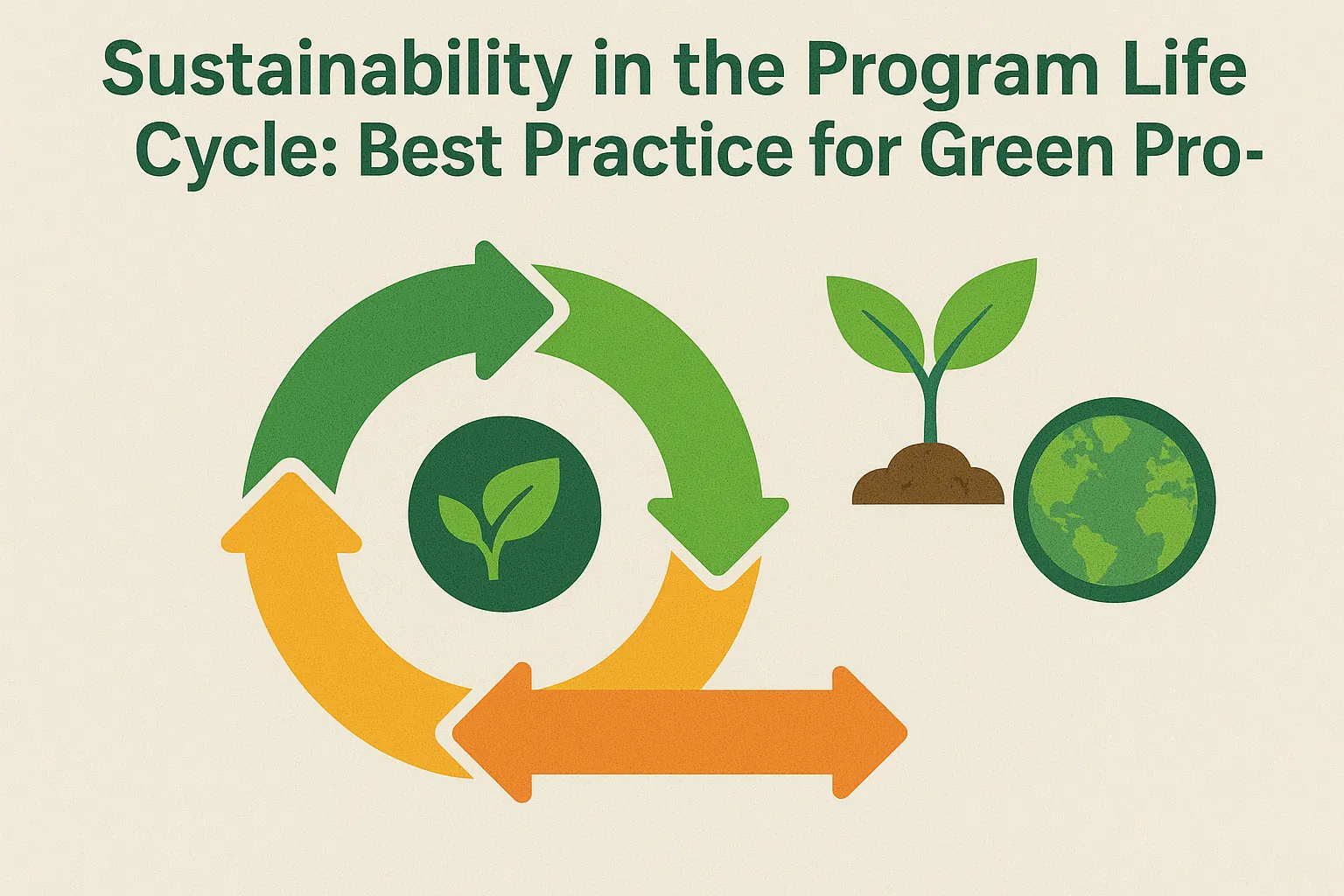Introduction to Program Life Cycle
Understanding the program life cycle is crucial for ensuring that projects are executed efficiently and effectively. The program life cycle encompasses a series of phases that guide project managers and teams from the inception of a project to its completion. This structured approach not only facilitates the successful delivery of projects but also allows for the integration of sustainability practices, which are increasingly vital in today’s eco-conscious landscape.
Defining the Program Life Cycle
The program life cycle consists of five key phases:
- Initiation: This phase involves defining the program’s purpose, scope, and objectives. It is essential to identify stakeholders and assess the feasibility of the program, laying the groundwork for subsequent phases.
- Planning: During this phase, detailed plans are developed to outline how the program will be executed. This includes resource allocation, budgeting, risk management, and scheduling. Sustainability considerations should be integrated into the planning process to ensure that environmental impacts are minimized.
- Execution: In this phase, the plans are put into action. Project teams carry out the tasks necessary to achieve the program’s objectives. Effective communication and collaboration among team members and stakeholders are critical to ensure that sustainability goals are met throughout the execution.
- Monitoring: Continuous monitoring is essential to track progress and performance against the established plans. This phase involves assessing whether the program is on track to meet its sustainability targets and making necessary adjustments to address any issues that arise.
- Closure: The final phase involves completing all program activities, delivering the final outputs, and conducting a thorough evaluation. This is an opportunity to reflect on the sustainability outcomes achieved and to document lessons learned for future projects.
Importance of Sustainability in Project Management
Sustainability has become a cornerstone of modern project management, reflecting a growing awareness of environmental issues and the need for responsible resource management. Integrating sustainability into the program life cycle is not just a trend; it is a necessity for several reasons:
- Regulatory Compliance: Many regions have implemented regulations that require projects to adhere to environmental standards. By incorporating sustainability into the program life cycle, organizations can ensure compliance and avoid potential legal issues.
- Stakeholder Expectations: As public awareness of environmental issues increases, stakeholders—including clients, investors, and the community—expect projects to demonstrate a commitment to sustainability. Meeting these expectations can enhance an organization’s reputation and foster trust.
- Long-term Viability: Sustainable practices can lead to cost savings, improved efficiency, and reduced waste, ultimately contributing to the long-term viability of projects and organizations. By considering sustainability throughout the program life cycle, project managers can create value that extends beyond immediate project outcomes.
Green Projects and Their Environmental Impact
Green projects are initiatives designed with the primary goal of minimizing environmental impact and promoting sustainability. These projects can range from renewable energy installations to sustainable urban development. The significance of green projects within the program life cycle includes:
- Resource Efficiency: Green projects often focus on using resources more efficiently, which can lead to reduced costs and lower environmental footprints.
- Innovation: The pursuit of sustainability encourages innovation in project design and execution, leading to the development of new technologies and practices that benefit both the environment and society.
- Community Benefits: By prioritizing sustainability, green projects can enhance community well-being, create jobs, and improve quality of life, demonstrating the broader impact of project management on society.
Understanding Sustainability in Project Management
Sustainability in project management refers to the practice of managing projects in a way that meets present needs without compromising the ability of future generations to meet their own needs. This concept emphasizes the importance of considering the long-term impacts of projects on the environment, society, and the economy. By integrating sustainability into the program life cycle, project managers can ensure that their projects contribute positively to the world while also achieving their objectives.
Defining Sustainability in Project Management
In the context of project management, sustainability encompasses a holistic approach that incorporates environmental stewardship, social responsibility, and economic viability. It involves making decisions that not only focus on immediate project outcomes but also consider the broader implications of those decisions on the planet and society. This approach encourages project managers to adopt practices that minimize negative impacts and enhance positive contributions to sustainable development.
The Three Pillars of Sustainability
Sustainability is often described through three interconnected pillars:
- Environmental Sustainability: This pillar focuses on minimizing the ecological footprint of projects. It involves practices such as reducing waste, conserving resources, and utilizing renewable energy sources. Project managers can implement strategies like eco-friendly materials, energy-efficient processes, and waste reduction techniques to promote environmental health.
- Social Sustainability: This aspect emphasizes the importance of social equity and community well-being. It involves engaging stakeholders, ensuring fair labor practices, and promoting inclusivity. By considering the social impacts of projects, managers can foster community support and enhance the quality of life for affected populations.
- Economic Sustainability: This pillar addresses the financial viability of projects. It involves ensuring that projects are economically feasible and provide long-term value. Sustainable economic practices include cost-effective resource management, investment in local economies, and the creation of jobs that contribute to community development.
Benefits of Integrating Sustainability into Project Management Practices
Integrating sustainability into project management practices offers numerous benefits, including:
- Enhanced Reputation: Organizations that prioritize sustainability often enjoy a better public image and increased trust from stakeholders. This can lead to improved customer loyalty and competitive advantage.
- Cost Savings: Sustainable practices can lead to significant cost reductions over time. For example, energy-efficient processes and waste reduction strategies can lower operational costs and increase profitability.
- Risk Mitigation: By considering environmental and social factors, project managers can identify potential risks early in the project life cycle. This proactive approach helps in avoiding costly delays and compliance issues.
- Innovation and Creativity: The pursuit of sustainable solutions often drives innovation. Project teams are encouraged to think creatively and develop new methods and technologies that can lead to more efficient and effective project outcomes.
- Long-term Impact: Projects that incorporate sustainability principles are more likely to have lasting positive effects on the environment and society. This aligns with the growing demand for corporate social responsibility and sustainable development goals.
Incorporating Sustainability in the Initiation Phase
The initiation phase is crucial for setting the foundation of a program, especially when it comes to integrating sustainability. By embedding sustainability considerations from the outset, project managers can ensure that eco-friendly outcomes are prioritized throughout the program life cycle. Here are some best practices for incorporating sustainability during this critical phase:
1. Identify Stakeholders and Their Sustainability Expectations
Understanding the perspectives and expectations of stakeholders is essential for aligning sustainability goals with project objectives. This involves:
- Engaging Stakeholders Early: Initiate discussions with all relevant stakeholders, including community members, clients, and environmental groups, to gather insights on their sustainability priorities.
- Mapping Stakeholder Interests: Create a stakeholder map that highlights their interests and concerns regarding sustainability. This will help in addressing their expectations effectively throughout the project.
- Establishing Communication Channels: Develop clear communication strategies to keep stakeholders informed and involved in sustainability discussions, ensuring their voices are heard and considered.
2. Develop a Sustainability Charter or Policy
A sustainability charter serves as a guiding document that outlines the program’s commitment to sustainable practices. Key steps include:
- Aligning with Project Goals: Ensure that the sustainability charter reflects the overall objectives of the project while incorporating specific sustainability targets.
- Defining Sustainability Principles: Articulate the core principles of sustainability that will guide decision-making processes, such as reducing waste, conserving resources, and promoting social equity.
- Setting Measurable Goals: Establish clear, measurable sustainability goals that can be tracked throughout the program life cycle, allowing for accountability and continuous improvement.
3. Conduct a Preliminary Sustainability Assessment
Before moving forward, it is vital to assess the potential environmental and social impacts of the project. This assessment should include:
- Identifying Potential Impacts: Analyze how the project may affect the environment, local communities, and economies. Consider factors such as resource consumption, emissions, and social implications.
- Utilizing Assessment Tools: Employ sustainability assessment tools and frameworks, such as Life Cycle Assessment (LCA) or Environmental Impact Assessments (EIA), to systematically evaluate potential impacts.
- Incorporating Findings into Planning: Use the insights gained from the assessment to inform project planning and decision-making, ensuring that sustainability considerations are integrated into all aspects of the program.
By focusing on these strategies during the initiation phase, project managers can lay a strong foundation for sustainable practices that will resonate throughout the program life cycle. This proactive approach not only enhances the project’s environmental performance but also fosters stakeholder engagement and supports long-term success in achieving eco-friendly outcomes.
Planning for Sustainable Outcomes
Incorporating sustainability into the program life cycle is essential for achieving eco-friendly outcomes in project management. This section outlines best practices for developing a sustainable project plan that aligns with the goals of sustainability officers and project managers.
1. Integrate Sustainability Objectives into the Project Scope and Deliverables
- Define Clear Sustainability Goals: Begin by embedding sustainability objectives directly into the project scope. This ensures that all stakeholders understand the importance of sustainability from the outset. For instance, if a project involves construction, specify the use of sustainable materials and energy-efficient designs as part of the deliverables.
- Engage Stakeholders Early: Involve stakeholders, including community members and environmental experts, during the planning phase. Their insights can help shape the project’s sustainability objectives and ensure that the project meets both community needs and environmental standards.
2. Establish Measurable Sustainability Goals and KPIs for Tracking Progress
- Set Specific, Measurable Goals: Develop sustainability goals that are specific and quantifiable. For example, aim to reduce carbon emissions by a certain percentage or to achieve a specific level of waste reduction. This clarity helps in tracking progress and making necessary adjustments throughout the project life cycle.
- Implement Key Performance Indicators (KPIs): Establish KPIs that align with your sustainability goals. These could include metrics such as energy consumption, waste generation, and resource utilization. Regularly monitor these KPIs to assess the project’s sustainability performance and make data-driven decisions.
3. Incorporate Sustainable Resource Management and Procurement Strategies
- Adopt Sustainable Procurement Practices: When sourcing materials and services, prioritize suppliers who demonstrate sustainable practices. This could involve selecting vendors who use recycled materials, have energy-efficient operations, or adhere to fair labor practices.
- Optimize Resource Use: Implement strategies to minimize resource consumption throughout the project. This includes using renewable energy sources, reducing water usage, and maximizing the efficiency of materials. For example, consider using digital tools to reduce paper waste and streamline communication.
- Plan for Lifecycle Impacts: Evaluate the environmental impact of resources not just during the project but throughout their entire lifecycle. This holistic approach ensures that sustainability is considered at every stage, from procurement to disposal.
By integrating these best practices into the program life cycle, project managers can significantly enhance the sustainability of their projects. This not only contributes to environmental preservation but also aligns with the growing demand for eco-friendly practices in project management.
Execution: Implementing Sustainable Practices
Particularly within the program life cycle, the execution phase is critical for translating plans into action. For sustainability officers and project managers, this phase presents a unique opportunity to embed eco-friendly practices that not only enhance project outcomes but also contribute to broader environmental goals. Here are some best practices for implementing sustainable practices during the execution phase:
1. Encourage Stakeholder Engagement and Collaboration
- Foster a Collaborative Environment: Engaging stakeholders—including team members, clients, suppliers, and the community—is essential for successful sustainability initiatives. By creating a platform for open dialogue, project managers can gather diverse perspectives and insights that can lead to innovative solutions.
- Establish Clear Sustainability Goals: Clearly defined sustainability objectives should be communicated to all stakeholders. This ensures that everyone understands the importance of these goals and their role in achieving them. Regular updates and feedback sessions can help maintain focus and motivation throughout the project.
- Involve Stakeholders in Decision-Making: Involving stakeholders in the decision-making process regarding sustainable practices can enhance buy-in and commitment. This collaborative approach not only improves the quality of decisions but also fosters a sense of ownership among participants.
2. Adopt Eco-Friendly Technologies and Processes
- Utilize Green Technologies: Integrating eco-friendly technologies into project execution can significantly reduce environmental impact. This may include using renewable energy sources, energy-efficient equipment, and sustainable materials. For instance, solar panels or energy-efficient lighting can be incorporated into construction projects to minimize energy consumption.
- Implement Sustainable Processes: Streamlining processes to reduce waste and enhance efficiency is crucial. Techniques such as lean project management can help identify and eliminate wasteful practices, thereby promoting sustainability. Additionally, adopting circular economy principles—where resources are reused and recycled—can further enhance eco-friendliness.
- Train Team Members on Sustainable Practices: Providing training and resources to team members on sustainable practices ensures that everyone is equipped to contribute effectively. This can include workshops on waste reduction, energy conservation, and sustainable sourcing.
3. Monitor Compliance with Sustainability Goals
- Establish Key Performance Indicators (KPIs): To effectively monitor sustainability efforts, it is essential to establish KPIs that align with the project’s sustainability goals. These metrics can help track progress and identify areas for improvement. Regularly reviewing these indicators allows project managers to make informed decisions and adjustments as needed.
- Conduct Regular Audits and Assessments: Periodic audits of sustainability practices can help ensure compliance with established goals. These assessments can identify gaps in implementation and provide opportunities for corrective actions. Engaging third-party evaluators can also lend credibility to the assessment process.
- Adapt and Adjust Strategies: The dynamic nature of project execution may require adjustments to sustainability strategies. Being flexible and responsive to new information or changing circumstances is vital. This adaptability can lead to more effective outcomes and a stronger commitment to sustainability.
By integrating these best practices into the execution phase of the program life cycle, sustainability officers and project managers can significantly enhance the environmental performance of their projects. This not only contributes to eco-friendly outcomes but also positions organizations as leaders in sustainable project management.
Monitoring and Reporting on Sustainability Performance
The integration of sustainability is not merely an add-on but a fundamental aspect that can significantly influence project outcomes. Monitoring and reporting on sustainability performance are critical components that ensure eco-friendly practices are not only implemented but also evaluated effectively. Here are some key points to consider:
Role of Sustainability Metrics in Project Performance Evaluation
- Defining Success: Sustainability metrics serve as benchmarks for evaluating the environmental, social, and economic impacts of a project. By establishing clear metrics, project managers can assess whether sustainability goals are being met throughout the program life cycle. Common metrics include carbon footprint, energy consumption, waste generation, and social equity indicators.
- Informed Decision-Making: These metrics provide valuable data that can inform decision-making processes. By analyzing sustainability performance, project managers can identify areas for improvement, allocate resources more effectively, and make adjustments to enhance overall project sustainability.
- Stakeholder Engagement: Metrics also play a crucial role in engaging stakeholders. By demonstrating progress through quantifiable data, project managers can build trust and support among stakeholders, including clients, community members, and regulatory bodies.
Tools and Methodologies for Tracking Sustainability Progress
- Sustainability Assessment Tools: Various tools are available to help project managers track sustainability progress. Life Cycle Assessment (LCA) tools, for instance, evaluate the environmental impacts of a project from inception to completion. Other tools include carbon calculators, sustainability dashboards, and project management software that integrates sustainability tracking features.
- Data Collection Methodologies: Employing robust data collection methodologies is essential for accurate tracking. This can include surveys, interviews, and automated data collection systems that monitor resource usage in real-time. Utilizing technology such as IoT devices can enhance data accuracy and timeliness.
- Benchmarking: Comparing sustainability performance against industry standards or similar projects can provide context and highlight areas for improvement. Benchmarking helps organizations understand their position relative to peers and encourages continuous improvement.
Best Practices for Transparent Reporting to Stakeholders
- Regular Reporting: Establishing a routine for reporting sustainability performance is vital. This could be quarterly or bi-annual reports that summarize progress against sustainability metrics. Regular updates keep stakeholders informed and engaged.
- Clear Communication: Reports should be clear, concise, and accessible. Using visual aids such as graphs, charts, and infographics can help convey complex data in an understandable manner. Tailoring reports to the audience—whether technical for project teams or high-level for executives—ensures that the information is relevant and actionable.
- Incorporating Feedback: Engaging stakeholders in the reporting process by soliciting feedback can enhance transparency and foster a collaborative environment. This feedback can be used to refine sustainability strategies and improve future reporting efforts.
- Highlighting Success Stories: Sharing case studies or success stories within reports can illustrate the positive impacts of sustainability initiatives. This not only showcases achievements but also serves as inspiration for future projects.
Closure and Lessons Learned: A Commitment to Continuous Improvement
Particularly within the context of sustainability, the closure phase of a program is not merely a formality; it is a critical opportunity to evaluate the effectiveness of eco-friendly initiatives and to ensure that lessons learned are documented for future endeavors. This section emphasizes the importance of assessing sustainability outcomes during project closure, which can significantly influence the success of future projects.
Conduct a Post-Project Review Focused on Sustainability Impacts and Achievements
- Assessment of Sustainability Goals: At the conclusion of a project, it is essential to conduct a thorough post-project review that specifically evaluates the sustainability impacts achieved. This involves measuring the extent to which the project met its environmental objectives, such as reducing carbon emissions, conserving resources, and promoting biodiversity. By quantifying these impacts, project managers can provide concrete evidence of the project’s success in contributing to sustainability.
- Stakeholder Feedback: Engaging stakeholders in the review process can yield valuable insights into the sustainability aspects of the project. Gathering feedback from team members, clients, and community representatives can help identify what worked well and what could be improved. This collaborative approach not only enhances the review process but also fosters a culture of transparency and accountability.
Document Lessons Learned and Best Practices for Future Projects
- Creating a Knowledge Repository: Documenting lessons learned is crucial for continuous improvement in sustainability practices. This documentation should include both successes and challenges faced during the project. By creating a knowledge repository, organizations can ensure that valuable insights are accessible for future projects, enabling teams to build on past experiences and avoid repeating mistakes.
- Best Practices for Sustainability: Alongside lessons learned, it is important to compile best practices that emerged during the project. These best practices can serve as guidelines for future projects, helping teams to implement effective sustainability strategies from the outset. Sharing these practices across the organization can also promote a unified approach to sustainability.
Encourage Ongoing Commitment to Sustainability in Future Programs
- Integrating Sustainability into Future Planning: The closure phase should not mark the end of sustainability efforts; rather, it should serve as a springboard for future initiatives. Project managers and sustainability officers should actively integrate the insights gained from the post-project review into the planning stages of upcoming programs. This proactive approach ensures that sustainability remains a priority throughout the program life cycle.
- Fostering a Culture of Sustainability: Encouraging a commitment to sustainability within the organization is essential for long-term success. This can be achieved by promoting ongoing training and awareness programs that emphasize the importance of sustainable practices. By instilling a culture of sustainability, organizations can empower their teams to prioritize eco-friendly outcomes in all future projects.
Conclusion
As we look towards the future of project management, the integration of sustainability into the program life cycle emerges as a pivotal strategy for achieving eco-friendly outcomes. Embracing sustainable practices not only enhances the environmental performance of projects but also offers a multitude of benefits that resonate with both organizational goals and societal needs.
Benefits of Integrating Sustainability
- Enhanced Resource Efficiency: By prioritizing sustainability, organizations can optimize resource use, reducing waste and lowering costs. This efficiency translates into significant savings over the project life cycle, benefiting both the environment and the bottom line.
- Improved Stakeholder Engagement: Sustainable projects often attract a broader range of stakeholders, including environmentally conscious investors and community members. Engaging these stakeholders fosters collaboration and can lead to innovative solutions that enhance project outcomes.
- Long-term Viability: Projects that incorporate sustainability are better positioned for long-term success. By addressing environmental impacts and aligning with global sustainability goals, organizations can ensure their projects remain relevant and resilient in a rapidly changing world.
Encouragement to Adopt Best Practices
Throughout this discussion, we have explored various best practices for integrating sustainability into the program life cycle, including:
- Conducting thorough sustainability assessments during the planning phase.
- Setting measurable sustainability goals and objectives.
- Engaging stakeholders in the decision-making process to foster a culture of sustainability.
- Implementing monitoring and evaluation mechanisms to track progress and adapt strategies as needed.
We encourage project managers and sustainability officers to adopt these practices actively. By doing so, they can lead their organizations toward more sustainable project outcomes, ultimately contributing to a healthier planet.
The Role of Project Managers and Sustainability Officers
Project managers and sustainability officers play a crucial role in driving sustainable change within their organizations. Their leadership is essential in:
- Championing Sustainability Initiatives: By advocating for sustainable practices, they can influence organizational culture and encourage team members to prioritize eco-friendly solutions.
- Facilitating Training and Development: Providing training on sustainability best practices equips project teams with the knowledge and skills necessary to implement these strategies effectively.
- Monitoring and Reporting: Regularly assessing the sustainability performance of projects and reporting on outcomes helps maintain accountability and transparency, fostering trust among stakeholders.
In conclusion, the future of sustainable projects lies in the hands of those who are willing to embrace change and prioritize sustainability in their program management practices. By integrating eco-friendly principles into the program life cycle, project managers and sustainability officers can lead the way toward a more sustainable future, ensuring that projects not only meet their objectives but also contribute positively to the environment and society as a whole.
Find out more about Shaun Stoltz https://www.shaunstoltz.com/about/.
This post was written by an AI and reviewed/edited by a human.



